Click on images to enlarge
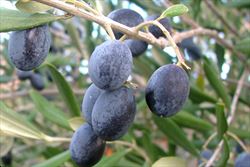
mature fruit of European olive, Olea europaea subsp. europaea (Photo: Sheldon Navie)

habit of older tree (Photo: Sheldon Navie)

rough bark on main trunk of older tree (Photo: Sheldon Navie)
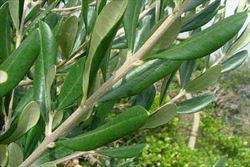
younger stem and paired leaves (Photo: Sheldon Navie)

close-up of European olive (Olea europaea subsp. europaea) leaves, showing their silvery undersides (Photo: Sheldon Navie)

African olive (Olea europaea subsp. cuspidata) leaves, showing their brownish-green undersides (Photo: Sheldon Navie)

close-up of African olive (Olea europaea subsp. cuspidata) leaves, showing their hooked tips (Photo: Sheldon Navie)
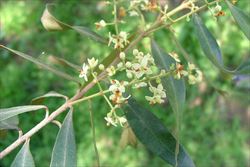
branched flower clusters (Photo: Sheldon Navie)
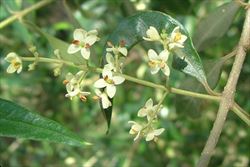
close-up of flowers (Photo: Sheldon Navie)
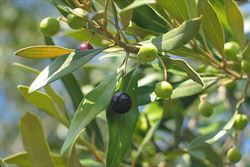
immature and mature fruit of African olive, Olea europaea subsp. cuspidata (Photo: Jackie Miles and Max Campbell)

immature fruit of European olive, Olea europaea subsp. europaea (Photo: Sheldon Navie)
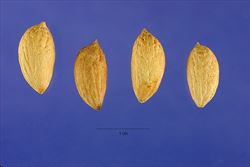
close-up of seeds (Photo: Steve Hurst at USDA PLANTS Database)
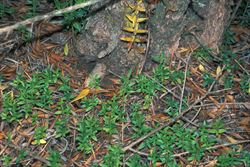
seedlings (Photo: Forest and Kim Starr, USGS)
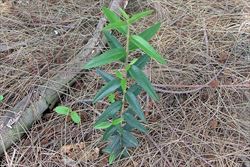
young plant (Photo: Sheldon Navie)
Scientific Name
Olea europaea L.
Synonyms
Olea africana Mill.
Olea chrysophylla Lam.
Olea
europaea L. subsp. africana (Mill.) P. Green
Olea
europaea L. subsp. cuspidata (Wall. ex G. Don) Cif.
Olea
europaea L. subsp. europaea
Olea europaea L. var.
nubica Schweinf. ex Baker
Olea officinarum
Crantz
Family
Oleaceae
Common Names
African olive, brown olive, common olive, European olive, olive, olive tree, small-fruited olive, wild olive
Origin
Common olive (Olea europaea) is native to southern Europe, northern Africa and western Asia. African olive (Olea europaea subsp. cuspidata) is native to Africa, Madagascar, the Mascarenes, western Asia, the Indian sub-continent and western China.
Cultivation
Widely cultivated as a garden ornamental, but also grown commercially for its fruit and for the production of olive oil.
Naturalised Distribution
Olive (Olea europaea) is occasionally naturalised in south-eastern and central Queensland.
African olive (Olea europaea subsp. cuspidata) is widely naturalised in the coastal and sub-coastal districts of eastern New South Wales. It is also locally naturalised in south-eastern South Australia and on Norfolk Island.
Common olive (Olea europaea subsp. europaea ) is widely naturalised in southern and eastern Australia, particularly in temperate regions. It is most common in south-eastern South Australia, but is also naturalised in the sub-coastal regions of central and northern New South Wales, in western and central Victoria, in many other parts of South Australia, and in the coastal and sub-coastal districts of south-western Western Australia.
Habitat
A weed of warmer temperate and semi-arid regions, particularly those with a Mediterranean type climate. It becomes naturalised in open woodlands, parks, lowland grasslands, waste areas and along roadsides and waterways.
Habit
An evergreen tree usually growing 2-10 m tall, but occasionally reaching up to 15 m in height.
Distinguishing Features
- an evergreen tree usually growing 2-10 m tall with much-branched upright stems.
- its oppositely arranged leaves are elongated in shape (3-7 cm long and 0.8-2 cm wide) with pointed or hooked tips.
- these leaves have glossy dark green upper surfaces and silvery, greenish or yellowish-brown undersides.
- its small creamy-white flowers have four petals that are joined into a very short tube at the base.
- its purplish-black oval-shaped fruit (15-30 mm long and 6-20 mm wide) contain a single hard seed (10-15 mm long) surrounded by oily flesh.
Stems and Leaves
The much-branched stems are greenish-black to silvery-green in colour and mostly held upright (i.e. erect). Older stems have a rough bark that is light or dark grey in colour, while younger stems are smooth or slightly ribbed.
The leaves are oppositely arranged with entire margins, that are often turned under (i.e. recurved). They are elongated in shape (3-10 cm long and 0.8-4 cm wide) and have pointed or hooked tips. These leaves have glossy dark green upper surfaces and silvery, whitish, greenish or yellowish-brown undersides.
Flowers and Fruit
The flowers are borne in small clusters at the ends of the branches or in the leaf forks (i.e. axils). They are creamy white in colour with four small petals joined into a very short tube (i.e. corolla tube) at the base (about 1-2 mm long) with lobes about 3 mm long. Flowering occurs mostly during spring.
The distinctive oval fruit (i.e. ellipsoid drupes) are green when immature and turn purplish-black in colour as they mature. These fruit (15-30 mm long and 6-20 mm wide) have a single 'stone' in the centre surrounded by oily flesh. The 'stone' is a hard brown seed that is oblong in shape (10-15 mm long).
Reproduction and Dispersal
This species reproduces mainly by seed, however it also produces suckers after plants are damaged.
Seeds are most commonly dispersed when the fruit are eaten by birds and other animals (e.g. foxes).
Environmental Impact
Common olive (Olea europaea) is regarded as a significant environmental weed in South Australia, and as an environmental weed in Victoria, Western Australia, New South Wales, Queensland and the ACT. It was recently listed as a priority environmental weed in at least one Natural Resource Management region.
Legislation
This species is not declared under any state or local government legislation in the region.
However, African olive (Olea europaea subsp. cuspidata) is a Class 4 Noxious Weed in the Ryde local authority area in central New South Wales, and non-cultivated olives are declared plants in South Australia.
Management
As this species is not a declared plant in the region, its control is not required. However, it is a potential environmental weed and should be managed in sensitive bushland and conservation areas.
For information on the management of African olive (Olea europaea subsp. cuspidata) see the New South Wales Department of Primary Industries Noxious and Environmental Weed Control Handbook, which is available online at http://www.dpi.nsw.gov.au.
Similar Species
Common olive (Olea europaea subsp. europaea) can be distinguished from African olive (Olea europaea subsp. cuspidata) by the following differences:
- common olive (Olea europaea subsp. europaea) has leaves with silvery-grey undersides and pointed tips.
- African olive (Olea europaea subsp. cuspidata) has leaves with pale greenish-brown undersides and prominently hooked tips.
Olives (Olea europaea) can also be confused with some native species (especially when not in fruit) including Australian olive (Olea paniculata), northern olive (Chionanthus ramiflora) and the mock olives (Notelaea spp.). These species can be distinguished by the following differences:
- olive (Olea europaea ) has leaves with silvery-grey or greenish-brown hairy (i.e. pubescent) undersides. Its flowers are borne in branched clusters (i.e. panicles) and its fleshy fruit are relatively large (15-30 mm long).
- Australian olive (Olea paniculata) has oppositely arranged leaves with paler green hairless (i.e. glabrous) undersides. Its flowers are borne in branched clusters (i.e. panicles) and its fleshy fruit are relatively small (about 10 mm long).
- northern olive (Chionanthus ramiflora) has oppositely arranged leaves with paler green hairless (i.e. glabrous) undersides. Its flowers are borne in branched clusters (i.e. panicles) and its fleshy fruit are relatively small (10-25 mm long).
- the mock olives (Notelaea spp.) have oppositely arranged leaves with hairy (i.e. pubescent) or hairless (i.e. glabrous) undersides. Their flowers are borne in unbranched clusters (i.e. racemes) and their fleshy fruit are relatively small (5-20 mm long).
Notes
African olive (Olea europaea subsp. cuspidata) is regarded as a significant environmental weed in New South Wales and on Norfolk Island. It was recently also listed as a priority environmental weed in at least one Natural Resource Management region.
Common olive (Olea europaea subsp. europaea) is regarded as a significant environmental weed in South Australia, and as an environmental weed in Victoria, Western Australia, New South Wales, Queensland and the ACT. It was recently listed as a priority environmental weed in at least one Natural Resource Management region.

